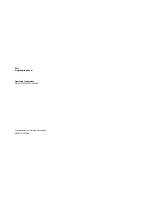
Part III: Appendixes
Glossary
310
power
up:
To turn on the computer.
power up mode:
One of two states: Resume or Boot, that determine what
happens when you press the power button to turn the computer on.
processor:
See
central processing unit
.
program:
A set of instructions that tells the computer what to do. A
program requires data (input), which is entered at the keyboard or by
means of a pointing device or obtained from a file. The computer
processes the data, according to the instructions in the program, and
sends the results to a device such as a screen, a printer or a disk. See
also
application, macro, utility
.
prompt:
An audible or visible signal, such as a beep or a screen message,
to make you aware that a process is complete or that you need to
perform an action such as entering a password. See also
system
prompt
.
properties:
Windows 95, Windows 98 and Windows NT treat windows,
icons, applications, disk drives, documents, folders, modems,
printers and so on as self-contained objects. Each object has its own
properties, such as the object’s name, size, position on-screen, and
color. You can change an object’s properties using the Properties
dialog box. See Windows Help for more information on changing
properties.
protocol:
A set of rules and conventions that makes it possible to transfer
information between computers. If you’re transmitting a file, both
modems must use the same protocol—just as two people talking on
the telephone must speak the same language to communicate
effectively.
R
radio frequency interference (RFI):
All computer equipment generates
radio frequency signals. The FCC regulates the amount of RFI a
computing device can leak past its shielding. A Class A device is
sufficient for office use. Class B is a more stringent classification
applying to equipment for home use. Toshiba computers comply
with Class B computing device regulations.
radio frequency interference (RFI) shield:
A metal shield enclosing the
printed circuit boards of the printer or computer to prevent
interference with radio and TV reception.
Summary of Contents for 8100 series
Page 17: ...xvii ...
Page 24: ......
Page 55: ...Part I Getting to Know Your Computer Getting Started When and how to turn off the computer 29 ...
Page 111: ...Part I Getting to Know Your Computer Learning the Basics Caring for your computer 85 ...
Page 136: ......
Page 185: ...Part II Technical Reference Toshiba Utilities Expansion device properties 159 ...
Page 219: ...Part II Technical Reference Keeping Your Files Safe Hard disk drive passwords Windows NT 193 ...
Page 277: ...Part II Technical Reference Troubleshooting Guide Toshiba s worldwide offices 251 ...
Page 278: ......
Page 285: ...Part III Appendixes Hot Keys 259 ...
Page 286: ...Appendix B Built in features 261 Optional accessories and devices 268 Specifications 270 ...
Page 298: ...Appendix C ...
Page 308: ...Appendix E ...
Page 312: ......
Page 342: ...Part III Appendixes Glossary 316 ...















































